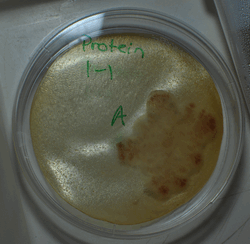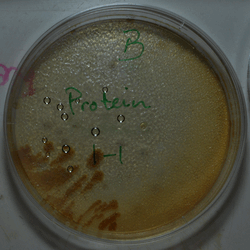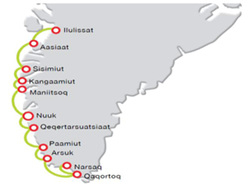Different project titles
Drinking/waste water (pH
values, chemicals and bacteries, water sourced)
By: Jane O. Kreutzmann, Najannguaq Inûsugtok´, Inuk Olsvig, Rune Olsen
So far we have visited the waterworks and interviewed them about the different things they do there, both chemical and technically. At the same time, we have taken notes and got our hands on relevant papers from the waterworks, which shows the different values of flow, useage and chemical add-ons.
So far we're planning to gather water samples from different taps in the town, and thereafter analyze them for bacterial and chemical content.
0/
We took samples from three different places in the town, primarily from the water machine in the school, from the Sipineq dormitories at the outskirt of the town and finally, from the town center.
We only managed to test the water samples for bacteria, which took quite some time and therefore didn't quite finish the other tests. The bacteria samples however were quite interesting. We made four bacteria cultures per water sample, of which two were protein based, where the sample water was diluted to 10% and the other was 100% sample water. The same goes for our malt-based cultures. Additionally, we tested for cholera bacteria in all samples.
The results made a clear pattern, despite our few samples. The water samples from Sipineq had no bacteria whatsoever, not even the smallest bacteria colonies were visible. However, the samples from the town center and the water machine in the school had developed bacteria colonies, the fact that the origin of the water samples were vastly different showed in the bacteria we found. The bacteria present in those two samples were quite different in looks and the way they had spread, there was a clear structural difference in both. Luckily for us, no cholera bacteria were found in any of the samples.
So far we have visited the waterworks and interviewed them about the different things they do there, both chemical and technically. At the same time, we have taken notes and got our hands on relevant papers from the waterworks, which shows the different values of flow, useage and chemical add-ons.
So far we're planning to gather water samples from different taps in the town, and thereafter analyze them for bacterial and chemical content.
0/
We took samples from three different places in the town, primarily from the water machine in the school, from the Sipineq dormitories at the outskirt of the town and finally, from the town center.
We only managed to test the water samples for bacteria, which took quite some time and therefore didn't quite finish the other tests. The bacteria samples however were quite interesting. We made four bacteria cultures per water sample, of which two were protein based, where the sample water was diluted to 10% and the other was 100% sample water. The same goes for our malt-based cultures. Additionally, we tested for cholera bacteria in all samples.
The results made a clear pattern, despite our few samples. The water samples from Sipineq had no bacteria whatsoever, not even the smallest bacteria colonies were visible. However, the samples from the town center and the water machine in the school had developed bacteria colonies, the fact that the origin of the water samples were vastly different showed in the bacteria we found. The bacteria present in those two samples were quite different in looks and the way they had spread, there was a clear structural difference in both. Luckily for us, no cholera bacteria were found in any of the samples.

This bacteria colony is from a protein-based culture from the water machine in the school.

This colony is from the town center, it is likewise in a protein-based culture.
Notice the difference between the bacterias here and the one from the water machine.
Notice the difference between the bacterias here and the one from the water machine.
The origin of the bacterias from the town center must have come from the waterpipes (or the tap), it's the most likely explanation given that the Sipineq dorms and the town center propably use the same network. The watermachine have a simple explanation, although it's not exactly appetizing, water machines aren't usually cleaned in the outer parts, only the main water tank is cleaned and the rest of the machine is left as it is. That leaves a pretty good place for bacteria growth, not diminished by the fact that lots of people use the machine.
Another conlcusion we can make is, that although we don't know what kind of bacteria they are, we can fasely say they aren't dangerous.
Another conlcusion we can make is, that although we don't know what kind of bacteria they are, we can fasely say they aren't dangerous.
Infrastructure (between cities, roads, airplanes)
By: Ilannguaq Karlsen
My plans for the project, Infrastructure
· Information about the international airport in Kangerlussuaq
· Air Greenland (Only company of planes in Greenland)
- Prices (4 weeks before departure in the distance of 500 km aprox. Nuuk to Sisimiut and Ilulissat to
Kangerlussuaq)
- Statistics ( Numbers of travellers in 2010(between towns and villages),(Out of Greenland)
- Traffic information
- Airplanes(How many available planes)
· Arctic Umiaq line(Ships)-->Traffic
· Communal --> Road tax information
· Oil prices in 2010(for cars and boats)
· Royal Arctic Line (Shipping goods, etc.)--> Goods traffic
- Plans in the future for infrastructure
Airport in Kangerlussuaq:
The airport in Kangerlussuaq is our only way to Europe except in summer where Narsarsuaq Airport is in use.
The landing chart is 2400 meters long.
Air Greenland:
Air Greenland is the only company that flies over Greenlandic air; except for Iceland air with is only used for Icelandic workers that are working in Greenland.
Air Greenland has 35 aircrafts, 23 helicopters and 12 airplanes.
Ticket prices:
For one adult and the tickets are One-way, booking 4 weeks prior to departure.
All prices are in DKK; the prices are the same other way around.
Kangerlussuaq to Copenhagen -2190 excl. taxes
Kangerlussuaq to Ilulissat – 995 excl. taxes
Kangerlussuaq to Nuuk – 1115 excl. taxes
My plans for the project, Infrastructure
· Information about the international airport in Kangerlussuaq
· Air Greenland (Only company of planes in Greenland)
- Prices (4 weeks before departure in the distance of 500 km aprox. Nuuk to Sisimiut and Ilulissat to
Kangerlussuaq)
- Statistics ( Numbers of travellers in 2010(between towns and villages),(Out of Greenland)
- Traffic information
- Airplanes(How many available planes)
· Arctic Umiaq line(Ships)-->Traffic
· Communal --> Road tax information
· Oil prices in 2010(for cars and boats)
· Royal Arctic Line (Shipping goods, etc.)--> Goods traffic
- Plans in the future for infrastructure
Airport in Kangerlussuaq:
The airport in Kangerlussuaq is our only way to Europe except in summer where Narsarsuaq Airport is in use.
The landing chart is 2400 meters long.
Air Greenland:
Air Greenland is the only company that flies over Greenlandic air; except for Iceland air with is only used for Icelandic workers that are working in Greenland.
Air Greenland has 35 aircrafts, 23 helicopters and 12 airplanes.
Ticket prices:
For one adult and the tickets are One-way, booking 4 weeks prior to departure.
All prices are in DKK; the prices are the same other way around.
Kangerlussuaq to Copenhagen -2190 excl. taxes
Kangerlussuaq to Ilulissat – 995 excl. taxes
Kangerlussuaq to Nuuk – 1115 excl. taxes
Arctic Umiaq Line:
Arctic Umiaq Line is a company that works with passenger ships big and small.
The biggest ship travels up and down between towns in the summer time.
The smaller ones that sail to settlements from towns are active year around.
This picture shows the route map of the biggest ship.
Future plans for infrastructure in Greenland:
The coming plans for infrastructure is that there will be a road that connects Kangerlussuaq and Sisimiut, and when this happen it will aid Greenland’s import and export and of course its economy.
There will be an international airport in Ilulissat, that makes Greenland or Ilulissat more available for tourist that travel from his or her own country and not through Denmark. This will aid Ilulissat’s fish export, for there will be bigger flow of fresh seafood coming out of Greenland.
Ilulissat’s harbor will be larger and of course more available for the cruise ships that comes to Ilulissat. All of these combined will greatly increase Greenland’s economy, but I’m not discussing all of the future plans now.
Cons:
There are some cons with the current infrastructure in Greenland.
It’s expensive to travel because of the distance, and we depend on the weather most of the time, and because we don’t have any trains or roads that connects the towns together. It will become a lot easier when there is roads and train that connects the towns. It will help bringing the Greenlandic community a lot closer, like for an example a student can come to his or her family easier and a lot cheaper.
The coming plans for infrastructure is that there will be a road that connects Kangerlussuaq and Sisimiut, and when this happen it will aid Greenland’s import and export and of course its economy.
There will be an international airport in Ilulissat, that makes Greenland or Ilulissat more available for tourist that travel from his or her own country and not through Denmark. This will aid Ilulissat’s fish export, for there will be bigger flow of fresh seafood coming out of Greenland.
Ilulissat’s harbor will be larger and of course more available for the cruise ships that comes to Ilulissat. All of these combined will greatly increase Greenland’s economy, but I’m not discussing all of the future plans now.
Cons:
There are some cons with the current infrastructure in Greenland.
It’s expensive to travel because of the distance, and we depend on the weather most of the time, and because we don’t have any trains or roads that connects the towns together. It will become a lot easier when there is roads and train that connects the towns. It will help bringing the Greenlandic community a lot closer, like for an example a student can come to his or her family easier and a lot cheaper.


